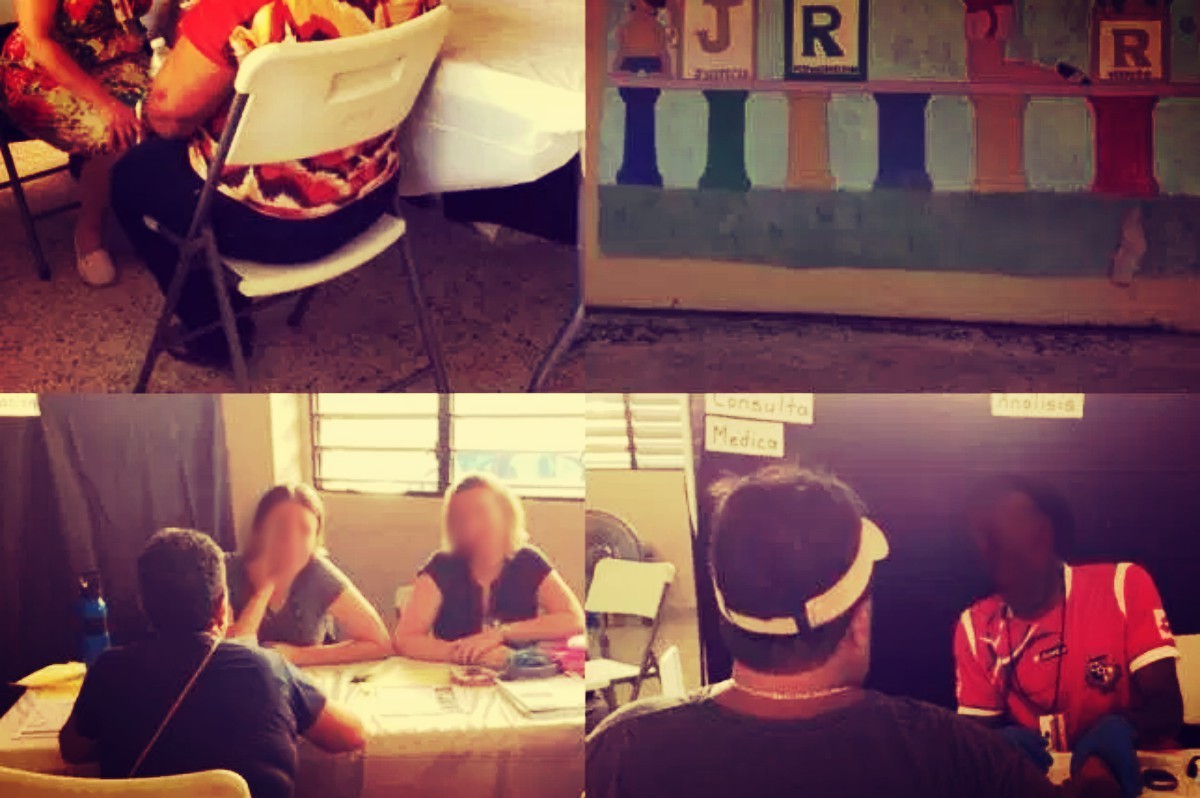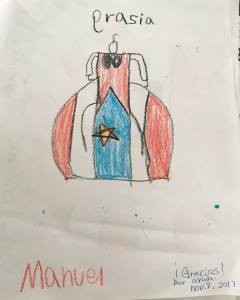Filed under: Action, Anarchist Movement, Caribbean, Disaster, Featured

Our current Mutual Aid Disaster Relief team in Puerto Rico has concentrated efforts mostly on HIV/AIDS prevention, safe water outreach/education, breastfeeding in disasters and also is addressing other health needs with our team of nurses, a lab chemist, lactation counselors and a medic.
We provided health education materials, triage, screening, and assisted 100 patients one of the first days we were here, based out of a little church 1/2 way up a mountain in a little community called Quebrada Prieta. This community lacks potable water: one woman was using the water from her pool to wash and clean, most are drinking from the river that drains from the rain forest. We were able to provide lab testing, exams, and assist a home bound, double amputee diabetic patient with a host of diabetes supplies.
Another day we were in Vega Baja, close to the ocean. We saw 89 patients in a pop-up clinic inside of a restaurant called El Right Field de Tommy. Since the storm, this restaurant has been providing free rice and beans every Tuesday to residents of this severely affected neighborhood. Yet another example of mutual aid in practice. Many of the folks seen had just got water back in their homes, but were unsure if it was safe to drink and some only had a steady drip coming out of the tap, insufficient for a day’s water needs. And yet others noted that some days the water worked and other days nothing came out of the taps. So we discussed ways to make water potable, such as boiling for 2 minutes if they have a gas stove or using a bleach + water recipe to make it safer to drink.
With so many people saving rainwater, we also talked about ways to safely store it and how to prevent mosquitoes. Very few in this community had generators. However we did do a home visit with a bedridden, oxygen dependent patient in which the generator was running outside of her bedroom windows. When we walked in we could smell it in her bedroom. We talked about the impact of carbon monoxide on her lungs and helped her husband move the generator to a safer spot, further away from his wife’s windows. We also got to do some more breastfeeding education as there were a lot of moms with babies and toddlers. Many of the moms were happily breastfeeding their babies. We were able to answer their questions and provide support and encouragement that they were doing the right thing.
Still another day, we saw 54 patients at a community Center in Los Naranjos, a community that saw flooding up to peoples necks during the storm. Most lost a lot, some lost everything, most have no potable water, none have electricity. All are helping each other: one woman had 70 people on her roof during the floods. The last 6 patients of the day were home bound. All of them are strong men women and kids. The oldest was 102 years old, the youngest was still in her moms belly!
There is a much wider context, including socioeconomic status and availability of resources that factor into health and food access. First, Puerto Rico had above 40% poverty before the storm; Unemployment was above 12%. Staying healthy and eating healthy costs more money, in the form of direct costs (for example: $4 for milk) and indirect costs (taking the day off work to care for a sick family member).
Second, going to the doctor or store implies that you have a car, which implies you are driving, which implies that your car didn’t flood or get blown to pieces in the storm. Then we must assume that you bought gas, which implies that you may have stood in line for 0 minutes to 2 hours (depending on the city, it’s short in the metro area), and all of this implies that you have money, which brings me to…
Returning to your job. Many people’s jobs are too damaged to even exist anymore or they cannot work the way they once did. For example, yesterday we saw a school that was destroyed, covered in mud, windows shattered to pieces, metal cables sticking out of cracked cement, no running water, bathroom walls crumbled. These children are not in school anymore. If their parents both used to work, someone now needs to stay home or adjust their schedule to take care of the kids during the work day or they can find someone else to care for their kids, which costs money. Their days are spent collecting water for washing and cleaning from the river; arriving early at the store or the water truck to stand in line for water that’s sold out within 20 minutes; cleaning up mud from every surface of their home; caring for sick or injured family and friends and neighbors; looking for accessible/cheap food; removing every piece of furniture that was submerged in water including the children’s mattresses which are now on the curb growing mold…. and the list goes on and on and on and on.
It’s not always possible to just go to the doctor. Sometimes the doctor is the one living the scenarios described above. Sometimes the traditional organizations tasked with assistance don’t have the people-power to maintain their services. Sometimes the closest store is miles away and the land you were living off is now a bare pile of sticks.
Here is a quote from Dr. Diana Negron, the director of the SILO Treatment Center, with whom we have been working alongside, “He who was poor before the storm is 1000 times more poor now. And if he wasn’t poor before the storm, he is becoming poorer each day.”
We brought down and distributed notes of support and solidarity from preschoolers and kindergartners in Florida.
The kids at the community center, El Ojo de Agua, made drawings for us thanking us for our work.
Of course it made me cry, I cannot express how grateful I am to serve the community day after day. It’s hard work and sometimes sad and sometimes one feels as if they’re not making a dent in all the needs in every town. But we’ve had people tell us that the storm brought them together, men have cried telling us about how they’ve lost everything yet they feel strong, elderly women living alone have declined supplies because they know someone else needs them more, neighbors have invited neighbors to live in their homes, and they share hugs with us, share drawings and offer us delicious rice and beans as a thank you. Our gratitude for these folks and for our ability to do this work is a bottomless well. Truly, it is us who should be thanking the people of Puerto Rico for their humbly and nobly navigating the worst, and still showing us humanity at its best.







